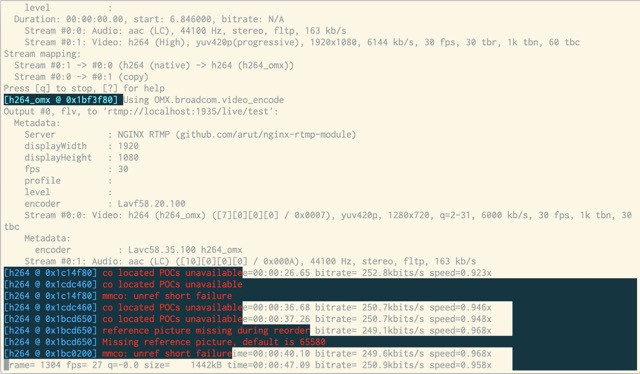

Please remember to replace in the Code with your actual IP-Address.To get started, change to the already known source folder: By using OpenMAX or rather the OpenMAX specific h264_omx codec in ffmpeg, the encoding runs on the GPU, thus drastically reducing the load on the CPU. Without getting too much into detail, the OpenMAX driver is a standard API stitting above the RPis VCHIQ kernel driver, which communicates with the VideoCore IV GPU. And that’s where OpenMAX IL API comes into play. the common used libx264 codec) and its high demand of CPU Power is not a proper option for the RPi, it is almost a obligation to use the RPis GPU to hardware accelerate the H.264 encoding process. Perhaps that might be appropiate for a full size tower computer with capable enough hardware to encode H.264 on the fly, but we are talking about a Raspberry Pi here.

It’s easy now to get in a rush and simply install ffmpeg/libav from the package sources and call it a day. Right now, just one of the two pillars (namely nginx and ffmpeg) are ready to support the roof (the webcam streams). Sudo service nginx restart Step 5 – Installing ffmpeg with OpenMAX H.264 GPU acceleration module Step 1 – Preparationsīefore beginning, make sure that your system is up to date and has all the necessary packages installed. This step by step guide will show all the taken steps and points out all the important actions. A Raspberry Pi 3 Plus was used to process the two video streams from the webcams using hardware acceleration and output them into a neat und clean website. To overcome this issue, two Logitech E3500 USB-Webcams, alongside with a lamp were placed inside the enclosure to monitor the printing using live streaming. Unfortunately this solution had a serious downside: It wasn’t possible to observe the Print while in process, since the necessary door-opening would have released the warm air. In Order to steadily surround a 3D Printer with warm air, a enclosure was built to keep the air near the printer to prevent plastic cracks and warping. The described tutorial is only applicable up to the Raspberry Pi 3B+ running Raspberry Pi OS 10 Buster, since the necessary OpenMAX IL API is only supported up to this version.


 0 kommentar(er)
0 kommentar(er)
